Cooling system pipes
Discussion
I'm still trying to fathom out the cooling system on my 350i, I don't think it's ever been right. It fills the expansion bottle during normal running; which by implication means that the air that should be in the expansion bottle is being pumped into the engine.
Anyway I'm looking at the 2.8i Capri installation as that's where the expansion tank comes from. On the Capri the top two connections on the expansion tank go to the highest points on 1)the engine and 2)the radiator through small diameter (degas) hoses, and the connection out of the bottom of the expansion tank goes into the radiator bottom hose with a large diameter pipe. All pretty logical.
However the Capri has a funny connection on the front of the plenum, circled in the pic:
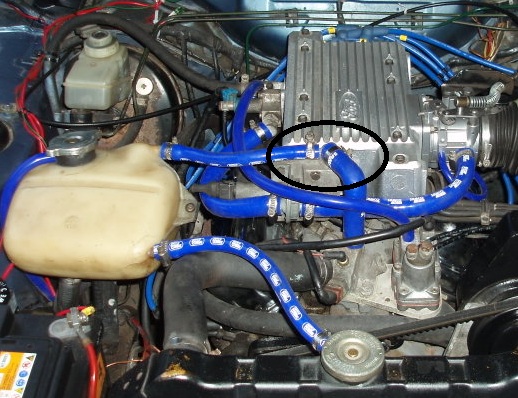
Can anyone with a 280i confirm what this plenum connection is?
Also does the 280i Tasmin have the bottom hose out of the expansion tank connected into the radiator bottom hose with large diameter pipe like the Capri?
Thanks...
Anyway I'm looking at the 2.8i Capri installation as that's where the expansion tank comes from. On the Capri the top two connections on the expansion tank go to the highest points on 1)the engine and 2)the radiator through small diameter (degas) hoses, and the connection out of the bottom of the expansion tank goes into the radiator bottom hose with a large diameter pipe. All pretty logical.
However the Capri has a funny connection on the front of the plenum, circled in the pic:

Can anyone with a 280i confirm what this plenum connection is?
Also does the 280i Tasmin have the bottom hose out of the expansion tank connected into the radiator bottom hose with large diameter pipe like the Capri?
Thanks...
Martin,
My car was piped up incorrectly from the factory, the 5/8" hose from the bottom of the expansion tank was piped into the the stagnant leg (with the heater turned off) of the return from the heater. This caused it to spew coolant each time the engine was shut down, if had been running with any enthusiasm.
I re-piped the bottom of the expansion tank in the 1980's to a tee which is in the hose to the heater, this cured this problem, what I have since always noticed it there is reasonable water from both the hoses to the top of the expansion tank, this has the benefit of bleeding any air from the cooling system during running.
Very interested in the Evans waterless coolant Andy T is looking at, as if Iv'e been caning it I have to let the engine cool for about 20 minutes before shut down, due to water boiling in the heads, not that I do often cane it though Just need to justify ~£200 for a coolant change!!!!
Just need to justify ~£200 for a coolant change!!!!
Regards,
Chris.
My car was piped up incorrectly from the factory, the 5/8" hose from the bottom of the expansion tank was piped into the the stagnant leg (with the heater turned off) of the return from the heater. This caused it to spew coolant each time the engine was shut down, if had been running with any enthusiasm.
I re-piped the bottom of the expansion tank in the 1980's to a tee which is in the hose to the heater, this cured this problem, what I have since always noticed it there is reasonable water from both the hoses to the top of the expansion tank, this has the benefit of bleeding any air from the cooling system during running.
Very interested in the Evans waterless coolant Andy T is looking at, as if Iv'e been caning it I have to let the engine cool for about 20 minutes before shut down, due to water boiling in the heads, not that I do often cane it though
 Just need to justify ~£200 for a coolant change!!!!
Just need to justify ~£200 for a coolant change!!!!Regards,
Chris.
taz turbo said:
Very interested in the Evans waterless coolant Andy T is looking at, as if Iv'e been caning it I have to let the engine cool for about 20 minutes before shut down, due to water boiling in the heads, not that I do often cane it though  Just need to justify ~£200 for a coolant change!!!!
Just need to justify ~£200 for a coolant change!!!!
Regards,
Chris.
Chris  Just need to justify ~£200 for a coolant change!!!!
Just need to justify ~£200 for a coolant change!!!!Regards,
Chris.
£200 is a bit pricey I got mine for £140 including the cleaning fluid. Which can be cleaned and used again! Which means the next car only cost £100
Andy
That capri photo does have the 5/8 dia pipe shown underneath, but it's not very obvious.
On my series 1 at least, the expansion tank has one small connection from plenum top, which is the highest point of engine (as you say), and one small connection from top of radiator. Its large pipe from underneath joins the heater pipe with a Tee. I'm pretty sure those small pipes are to stop air locks forming, and coolant can/does flow through them. The 2.8 has the air valve on that moulded part to the top small pipe, so it then warms up with the engine.
Also in many Fords of that era they did NOT have a heater on/off valve at all, they simply rerouted the airflow with a flap to get cold air, so didn't have to worry about bypasses etc. and this means the air valve would warm up anyway even without the small pipe...
TVR did it like the Capri EXCEPT they plumbed the 5/8 pipe into the heater RETURN side as the tank is on opposite side (as Taz Turbo says).
This means coolant runs constantly through the expansion tank, because the two small pipes are on the OUT side of the water pump, but the 5/8 pipe underneath is connected to the RETURN part of the circuit. If the heater is turned OFF with the valve, this flow increases, and flow is a LOT bigger when thermostat closed.
I think this is WRONG, because this setup partially bypasses both the heater matrix AND the raditor. It's only saved by the fact that those are small pipes ! The expansion tank is always HOT.
I have removed the small pipe from the rad on mine, on the basis that the water flow will tend to push out air from the rad when hot anyway, and reduce the flow through the expansion tank. The heater is noticeably hotter than before !! OK, now I've got 2 pressure caps, but it still works well.
I hope that helps as backround for your 350 - try to work out what's IN (cold) and OUT (hot) from the water pump and it will probably give you a clue ?
On my series 1 at least, the expansion tank has one small connection from plenum top, which is the highest point of engine (as you say), and one small connection from top of radiator. Its large pipe from underneath joins the heater pipe with a Tee. I'm pretty sure those small pipes are to stop air locks forming, and coolant can/does flow through them. The 2.8 has the air valve on that moulded part to the top small pipe, so it then warms up with the engine.
Also in many Fords of that era they did NOT have a heater on/off valve at all, they simply rerouted the airflow with a flap to get cold air, so didn't have to worry about bypasses etc. and this means the air valve would warm up anyway even without the small pipe...
TVR did it like the Capri EXCEPT they plumbed the 5/8 pipe into the heater RETURN side as the tank is on opposite side (as Taz Turbo says).
This means coolant runs constantly through the expansion tank, because the two small pipes are on the OUT side of the water pump, but the 5/8 pipe underneath is connected to the RETURN part of the circuit. If the heater is turned OFF with the valve, this flow increases, and flow is a LOT bigger when thermostat closed.
I think this is WRONG, because this setup partially bypasses both the heater matrix AND the raditor. It's only saved by the fact that those are small pipes ! The expansion tank is always HOT.
I have removed the small pipe from the rad on mine, on the basis that the water flow will tend to push out air from the rad when hot anyway, and reduce the flow through the expansion tank. The heater is noticeably hotter than before !! OK, now I've got 2 pressure caps, but it still works well.
I hope that helps as backround for your 350 - try to work out what's IN (cold) and OUT (hot) from the water pump and it will probably give you a clue ?
Edited by RCK974X on Friday 21st December 22:46
Thanks for the replies guys. Interesting that the consensus is that the 280i/turbo plumbing doesn't make sense either - I guess the same guy at TVR did both the 350 and 280 designs so it's more than likely that if one is 'odd' the other will be too! So the 280i plenum connection is an 'extra air device' for cold starts so needs hot water with the thermostat closed. Makes sense; but gives a flow of water into the expansion tank at all times.
The 350i seems to be plumbed the same way as the 280 in that there's a reasonably large flow though the expansion tank with the thermostat closed (through the plenum heater); however on the 350 the bottom tank connection is connected to the radiator vent through a very small pipe... ie there's nowhere for the flow to go, so the expansion tank fills up, pushing air into the other vent connection that is connected to the top hose. On an SD1 that plenum heater flow goes back into the heater return pipe so the engine will warm up much more quickly.
Interesting what's been said about the 280 heater - the whole reason I'm getting into this is that the heater in my car is so bad that it won't demist the car; part of the issue seems to be that the flow of water with the thermostat closed appears to be mostly through the expansion tank and not through the heater matrix. At the Christmas 'do' I saw three different sets of heater plumbing on V8s, so clearly TVR were doing some 'on the fly' heater development!
Which side of the car does the heater inlet pipe go through the bulkhead on a 280?
The 350i seems to be plumbed the same way as the 280 in that there's a reasonably large flow though the expansion tank with the thermostat closed (through the plenum heater); however on the 350 the bottom tank connection is connected to the radiator vent through a very small pipe... ie there's nowhere for the flow to go, so the expansion tank fills up, pushing air into the other vent connection that is connected to the top hose. On an SD1 that plenum heater flow goes back into the heater return pipe so the engine will warm up much more quickly.
Interesting what's been said about the 280 heater - the whole reason I'm getting into this is that the heater in my car is so bad that it won't demist the car; part of the issue seems to be that the flow of water with the thermostat closed appears to be mostly through the expansion tank and not through the heater matrix. At the Christmas 'do' I saw three different sets of heater plumbing on V8s, so clearly TVR were doing some 'on the fly' heater development!
Which side of the car does the heater inlet pipe go through the bulkhead on a 280?
The Cologne block pushes hot water out the top (common/standard for most engines), so the heater inlet is the pipe on the left hand side, looking at front of engine/airbox, connecting to casting under the air valve and the small top pipe connection. The heater return then comes back to the thermostat cover. Cologne is a bit unusual as thermostat is at bottom of engine, with a bypass arrangement to heat it up.
Heater IN goes along LHS of engine and in through air inlet box (also LHS). Return comes out RHS to the Tee for expansion tank. TVR plumbed a valve in the return pipe.
Well, at least that's how mine is plumbed.
Actually I've been wondering if I should have only a connection to that top small engine outlet, and use a BL type oveflow tank with just one small pipe. Hmmm....but that may not work as air valve then won't be warmed up if heater valve closed...
Carbed Colognes (Granny and Cortina) didn't have that small top outlet at all, but their water plumbing was lower (and always below rad) and they had a 'classic' single small pipe from rad cap...and no heater valve (as far as I know)
Might be worth checking out how original 3.5 SD1 Rovers were plumbed up ?
Heater IN goes along LHS of engine and in through air inlet box (also LHS). Return comes out RHS to the Tee for expansion tank. TVR plumbed a valve in the return pipe.
Well, at least that's how mine is plumbed.
Actually I've been wondering if I should have only a connection to that top small engine outlet, and use a BL type oveflow tank with just one small pipe. Hmmm....but that may not work as air valve then won't be warmed up if heater valve closed...
Carbed Colognes (Granny and Cortina) didn't have that small top outlet at all, but their water plumbing was lower (and always below rad) and they had a 'classic' single small pipe from rad cap...and no heater valve (as far as I know)
Might be worth checking out how original 3.5 SD1 Rovers were plumbed up ?
Edited by RCK974X on Friday 21st December 22:48
Just adding a note - I remembered there are 'bypass' heater valves, which have FOUR connections, and effectively switch the heater in and out of the water circuit completly. When cold, they allow water straight through, rather than blocking the flow.
That may be another way to go to help with the problem ?
That may be another way to go to help with the problem ?
RCK974X said:
The Cologne block pushes hot water out the top (common/standard for most engines), so the heater inlet is the pipe on the left hand side, looking at front of engine/airbox, connecting to casting under the air valve and the small top pipe connection. The heater return then comes back to the thermostat cover.
Andy is correct, I reversed the flow and return in my description, sorry for any confusion caused.Chris.
Interesting... so the 280i heater is plumbed the opposite way to the 350. The '86 350/390 flow is into the heater matrix on the left hand side (opposite the driver on a RHD car) - I think that's wrong, sounds like the 280 is correct. The 400 and later 350's are different.
One car I looked at (an '89 350) had the '4 way' bypassed heater valve; my '86 doesn't; 'development' on the fly...
I have also studied the SD1 cooling system; that has the plenum heater plumbed back into the heater return and not connected to the expansion tank; I intend to replicate that. The SD1 is different though; the 'de-airation' function is in the top of the radiator and the 'expansion' tank is purely an overflow tank in the way that later wedges had a second tank connected into the cap of the 'Capri' tank. 'Development' again!
One car I looked at (an '89 350) had the '4 way' bypassed heater valve; my '86 doesn't; 'development' on the fly...
I have also studied the SD1 cooling system; that has the plenum heater plumbed back into the heater return and not connected to the expansion tank; I intend to replicate that. The SD1 is different though; the 'de-airation' function is in the top of the radiator and the 'expansion' tank is purely an overflow tank in the way that later wedges had a second tank connected into the cap of the 'Capri' tank. 'Development' again!
The Hatter said:
I have also studied the SD1 cooling system; that has the plenum heater plumbed back into the heater return and not connected to the expansion tank; I intend to replicate that. The SD1 is different though; the 'de-airation' function is in the top of the radiator and the 'expansion' tank is purely an overflow tank in the way that later wedges had a second tank connected into the cap of the 'Capri' tank. 'Development' again!
...but is the rad on an SD1 not higher relative to the engine than on a Wedge? Thus on a Wedge you need the 'de-aeration' point to be higher up in the system.The Hatter said:
Interesting... so the 280i heater is plumbed the opposite way to the 350. The '86 350/390 flow is into the heater matrix on the left hand side (opposite the driver on a RHD car) - I think that's wrong, sounds like the 280 is correct. The 400 and later 350's are different.
<..snip..>
Is the matrix mounted at an angle in wedges? I don't know on my 2.8, never had it apart.<..snip..>
I say this because some heater matrixes are set at an angle to aid air bubble flushing - connecting these the wrong way round DOES make a difference. If it is are horizontal, then it probably won't make much difference. Heater could also be blocked or partially blocked.
That small outlet on the top of the 280 is the highest point on the wedge (and on the Capri) so air bubbles should eventually get flushed to the expansion tank. I do notice that after changing antifreeze/flushing etc I have to top up the tank several times before water level settles, which shows the 2.8 takes a while before all the air has gone...
Edited by RCK974X on Monday 24th December 08:15
This is a topic that i have thought about for a long time. i have had both a sd1 v8 and dont laugh a TR8. the height of the rad on both of these was higher than on the wedge but they were also different heights to each other so not sure what difference if any it makes. The big thing is the expansion tank and outlet pipes.Both sd1 and TR8 use the same expansion tank i.e sd1 style which has a smaller diameter pipe that runs to the top of the rad than the wedge design. now why TVR went with this rather than the sd1 setup is anyone's guess. i for sure will when the plastic expansion tank splits try the sd1 tank and pipe setup.
The SD1 rad is higher than that in the wedge which is probably the reason for TVR using the Capri tank, amd positioning it as high as they could in the engine bay. I don't think they put enough thought into what the effects of the plumbing were; or (more likely) they chose the easy/cheap option that seemed to work. The evidence is that they kept meddling with the cooling system so I suspect it wasn't quite right on early cars.
My heater matrix is vertical with a high inlet connection on the passenger side (RHD):
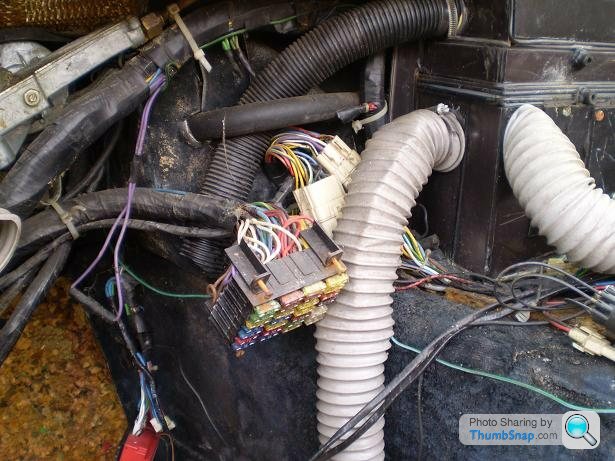
And a low outlet connection on the driver's side (hard to see in the pic but it's there!)
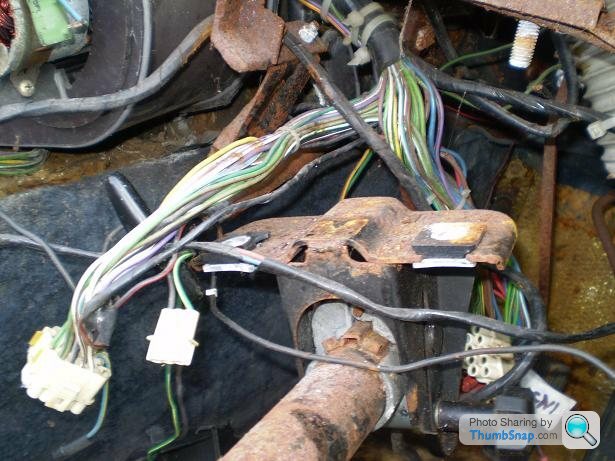
The pics are my '86 SEAC but the 350i (also '86) looks very similar as far as I can tell.
I've bought all the bits I need to replumb, so as soon as the inlet manifold is back from welding (long story!) I'll be putting my ideas into practice.
My heater matrix is vertical with a high inlet connection on the passenger side (RHD):

And a low outlet connection on the driver's side (hard to see in the pic but it's there!)

The pics are my '86 SEAC but the 350i (also '86) looks very similar as far as I can tell.
I've bought all the bits I need to replumb, so as soon as the inlet manifold is back from welding (long story!) I'll be putting my ideas into practice.
Update time... I've now plumbed both my 350i and the SEAC to what I think they should be; both cars have been running all summer without overheating or spitting coolant out; and I have effective heat and demisting on demand.
Basically I've done three things, centred around the expansion tank:
1) Changed the 'de-gas' system - ie the engine and radiator vent lines
2) Rerouted the plenum heater outlet pipe
3) Put a 'tee-piece' in the radiator bottom hose.
The de-gas system; note the blocked off middle connection on the expansion tank. The highest point on the radiator and the highest point on the engine (the swan neck) are now connected to the highest point on the expansion tank:
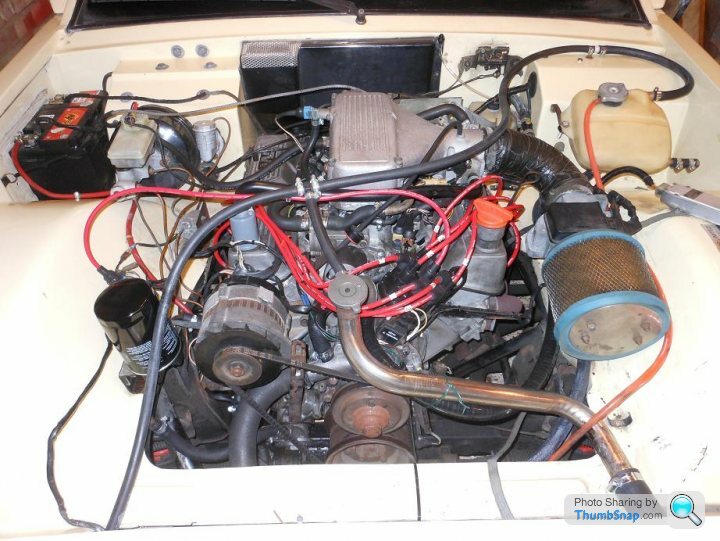
The plenum heater outlet is connected to the heater return pipe on the water pump inlet, as it is on the SD1 - and NOT the expansion tank middle connection.
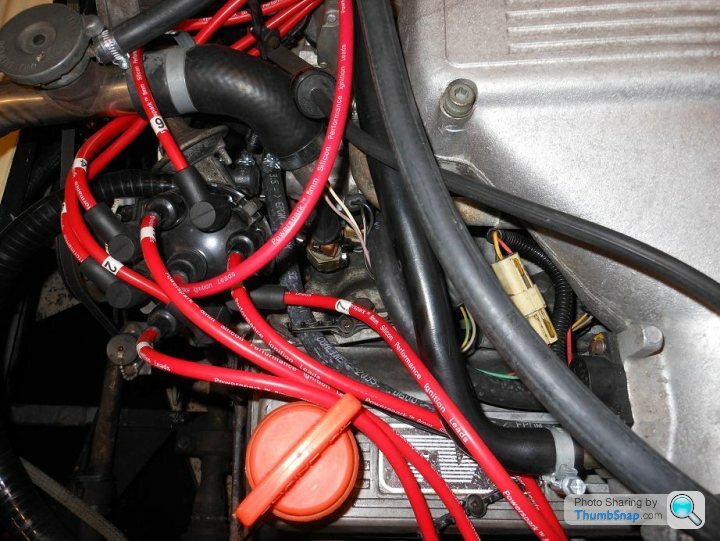
And the bottom pipe on the expansion tank (the 5/8 diameter one) is connected to a tee-piece in the radiator bottom hose, replacing the original bottom hose 'straight' section.
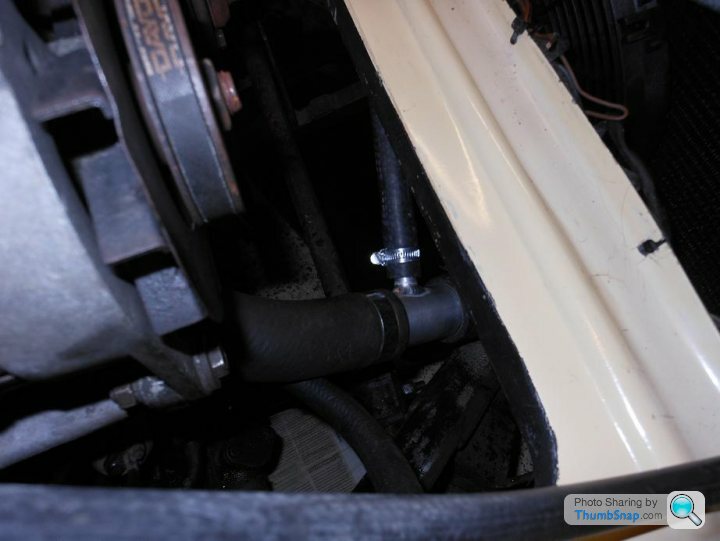
With TVR's set up, the plenum heater outlet pumped coolant into the expansion tank, resulting in air being forced into the swan neck and then through the rad into the engine- so the expansion tank was always full and the engine (and heater) always had air in it... not clever! With the set up I now have, the engine and heater are always full of coolant and there's always air in the top of the expansion tank, where it should be.
I have also found that it's much better to switch the fan in manually when the car comes to a standstill rather than wait for the radiator mounted otter switch to activate the fan. I believe the rad mounted otter switch is too far away from the engine and is too slow to react; when Rover/MG fitted electric fans they put the sensor (otter switch equivalent) onto the thermostat cover, ie right on top of the engine.
I've done what I think is right, feel free to shoot me down with 'TVR knew what they were doing' flames but I know that my cars now run much better than they did before so I'm happy! I looked at lots of cars at the fest and there were many variations on the plumbing theme; one thing I did find interesting though was that early cars (Mr Tank's) were plumbed in a similar way that I have now done mine - I'm not sure why TVR moved away from that. My suspicion is that the electric fan set up on the 350s didn't work very well; my solution of mimicing a viscous fan by manually switching in the fan when the car is at a standstill probably wouldn't have been acceptable to buyers of new TVRs back in the day...
Basically I've done three things, centred around the expansion tank:
1) Changed the 'de-gas' system - ie the engine and radiator vent lines
2) Rerouted the plenum heater outlet pipe
3) Put a 'tee-piece' in the radiator bottom hose.
The de-gas system; note the blocked off middle connection on the expansion tank. The highest point on the radiator and the highest point on the engine (the swan neck) are now connected to the highest point on the expansion tank:

The plenum heater outlet is connected to the heater return pipe on the water pump inlet, as it is on the SD1 - and NOT the expansion tank middle connection.

And the bottom pipe on the expansion tank (the 5/8 diameter one) is connected to a tee-piece in the radiator bottom hose, replacing the original bottom hose 'straight' section.

With TVR's set up, the plenum heater outlet pumped coolant into the expansion tank, resulting in air being forced into the swan neck and then through the rad into the engine- so the expansion tank was always full and the engine (and heater) always had air in it... not clever! With the set up I now have, the engine and heater are always full of coolant and there's always air in the top of the expansion tank, where it should be.
I have also found that it's much better to switch the fan in manually when the car comes to a standstill rather than wait for the radiator mounted otter switch to activate the fan. I believe the rad mounted otter switch is too far away from the engine and is too slow to react; when Rover/MG fitted electric fans they put the sensor (otter switch equivalent) onto the thermostat cover, ie right on top of the engine.
I've done what I think is right, feel free to shoot me down with 'TVR knew what they were doing' flames but I know that my cars now run much better than they did before so I'm happy! I looked at lots of cars at the fest and there were many variations on the plumbing theme; one thing I did find interesting though was that early cars (Mr Tank's) were plumbed in a similar way that I have now done mine - I'm not sure why TVR moved away from that. My suspicion is that the electric fan set up on the 350s didn't work very well; my solution of mimicing a viscous fan by manually switching in the fan when the car is at a standstill probably wouldn't have been acceptable to buyers of new TVRs back in the day...
I have an interesting idea to automate your manual switch - sense the airflow through the rad and when it drops, automatically start the fan for (say) 2 minutes, long enough for the otter to take over.
Here's how it works - a small controller unit connected to the fan, battery (ignition switched), ground, and the temperature sender.
The controller only kicks in if the temp sender is showing over (say) 70C to start with.
Here's the clever bit - the controller monitors the voltage on the fan. When you're moving and the fan is disconnected, air flow through the rad actually turns it into a windmill generator (I've noticed this effect when I connected a tell-tale bulb to the fan to tell when it's on with a light on the dash - over 40mph it starts to glow).
When the fan voltage drops off, airflow is down, time to start the timer and run the fan. If the otter cuts in then it can take over after the timer stops.
I'll knock up some prototypes but it should be quite easy to install and a useful enhancement.
Here's how it works - a small controller unit connected to the fan, battery (ignition switched), ground, and the temperature sender.
The controller only kicks in if the temp sender is showing over (say) 70C to start with.
Here's the clever bit - the controller monitors the voltage on the fan. When you're moving and the fan is disconnected, air flow through the rad actually turns it into a windmill generator (I've noticed this effect when I connected a tell-tale bulb to the fan to tell when it's on with a light on the dash - over 40mph it starts to glow).
When the fan voltage drops off, airflow is down, time to start the timer and run the fan. If the otter cuts in then it can take over after the timer stops.
I'll knock up some prototypes but it should be quite easy to install and a useful enhancement.
I recently found an article on a Range Rover site where an owner updated his expansion tank using the same pipe route. He also used a Merc E Class W126 expansion tank to save blocking off an outlet to avoid any risks associated with the pressure build up which I have also copied. His post was very scientiffic justifying what he did and he arrived with same results. I too have done away with the Otter switch and have set up my override manually using a switch wired into my dash.
Having read this post as well as the other, I shall reset my pipe work using the same routing benefitting from not having the heat soak as an Efi engine. The Merc expansion fits nicely where the old type did albeit I have moneyed mine on the firewall and not the inner wing. Pics on request.
Having read this post as well as the other, I shall reset my pipe work using the same routing benefitting from not having the heat soak as an Efi engine. The Merc expansion fits nicely where the old type did albeit I have moneyed mine on the firewall and not the inner wing. Pics on request.
Morning all,
Been getting the 280i I bought some ten or so years ago back up to scratch after over looking if for various wedges a 450 Chim and now a Tuscan.
I amd currently replace all the rubber and changing most of the gaskets before a good service.
I just read this post and realised that my 280i does not have an expansion tank! always ran lovley when I used to use it more.
Any one else not got one?
Cheers
Been getting the 280i I bought some ten or so years ago back up to scratch after over looking if for various wedges a 450 Chim and now a Tuscan.
I amd currently replace all the rubber and changing most of the gaskets before a good service.
I just read this post and realised that my 280i does not have an expansion tank! always ran lovley when I used to use it more.
Any one else not got one?
Cheers
Gassing Station | Wedges | Top of Page | What's New | My Stuff




